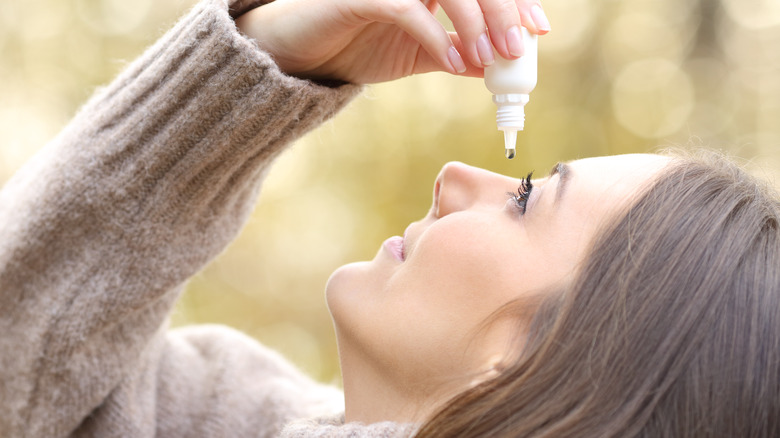Why Your Eyes Are Always Watering When It's Cold Outside
Winter weather can be harsh on our skin, extremities, and even our emotional state of mind. It's not uncommon to experience dry lips, cold fingertips, or seasonal affective disorder (SAD) towards the end of the year. Another physical reaction we frequently experience during wintertime is the watering of our eyes as we face freezing temperatures and blistering winds outside. Why is it that as soon as we step out into the cold, we suddenly start to tear up?
The answer can be traced to hydration — or lack thereof, really. Our tears serve an important purpose. With every blink, our tear glands produce tears that get deposited across our cornea in the form of "tear film," according to the National Eye Institute. Made up of oil, fluid, and mucus, tears keep our eyes nice and moist. This moisture helps prevent infection, keeps contaminants out of our eyes, and allows us to see images more sharply. On cold days, however, powerful wind gusts and plunging temperatures suck this much-needed moisture from our eyes.
Dry eye and photokeratitis
Cold weather prompts tear evaporation, reports Ducklo Eye Group. Similar to how wintertime weather dries out our skin, this lack of moisture dries out our eyes. But wait a minute, how is it that dehydration is the cause of overly teary eyes? Well, to make up for lost tear film, our glands compensate by producing an excess of tears. So much so that we may experience watery eyes while outdoors.
Alternatively, there's another reason why you might find yourself "crying" while outside in the cold. Medically referred to as photokeratitis, the condition occurs when the eye suffers injury due to UV ray exposure (via the American Academy of Ophthalmology). Looking directly at the sun without proper eye protection is one way in which this damage can occur, but the reflection of UV rays can also cause harm, such as light that bounces off of snow. Specifically referred to as snow blindness, the condition can also occur in response to severely dry air or in the event that the top layer of the cornea freezes over. In addition to light sensitivity, redness, pain, and blurred vision, tearing is another symptom of photokeratitis.
How to keep your eyes hydrated in order to prevent watery eyes
If photokeratitis is the cause of your watery eyes, using artificial tear products, over-the-counter (OTC) pain-relief medications, or placing a cold rag over your eyes can help provide relief (via the American Academy of Ophthalmology). With these treatment methods, you should start to feel better within approximately two days. To avoid eye damage to begin with, always wear UV-ray-blocking sunglasses or snow goggles while outside in the cold.
If your excess tears are due to dry eyes, similar treatment methods can be implemented. This includes donning sunglasses on windy winter days, using OTC artificial tears, drinking plenty of water, and running a humidifier while indoors (per Ducklo Eye Group). When outside, be sure to blink frequently. Remember, our body disperses tears each time we blink, which can help preserve moisture during those chillier months of the year and prevent overly watery eyes.


